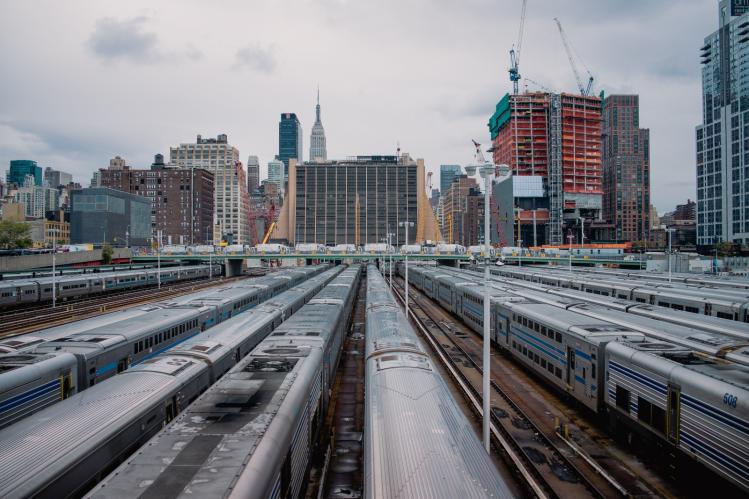
Since at least the Reagan administration, local and state officials across the country have bemoaned the federal government’s withdrawal from funding construction of housing for the poor. But now, both Democrats and Republicans in Washington, D.C. are looking at ways to hold localities accountable for zoning that discourages the creation of affordable housing.
There is a rare sliver of common ground between proposals pushed by some of the Democratic presidential aspirants and a Trump-administration effort to identify “land use requirements, and administrative practices that artificially raise the costs of affordable housing development and contribute to shortages in housing supply.” That is: Which carrot or stick should the federal government wield to overcome exclusionary zoning practices that limit the production of much-needed affordable housing?
“It is clearly bi-partisan,” said Adrianne Todman, chief executive officer of the National Association of Housing and Redevelopment Officials. “The question is: the devil is always in the details. Which restrictions are we talking about?”
Zoning, or the regulation of land use and building, has traditionally been a hyperlocal matter in the United States. A proposed zoning change can be a blasting cap for neighborhood political passions as decisions are worked out in town halls and county meeting rooms on the traffic flow at the 7-Eleven, the shadow of an apartment building, the off-street parking for a medical office. What some might see as a piece of the American Dream—a big home on a large, leafy lot—might also look like exclusionary zoning that enforces racial segregation. These are uncertain places where politicians fear to tread.
What’s clear is the need, especially among the poorest. The number of households paying more than half their income for rent shot up by 45 percent from 2001 to 2017, according to the Joint Center for Housing Studies of Harvard University. There simply aren’t enough apartments affordable for the very poor: just 37 for every 100 households in need.
As a result, the number of unsheltered homeless people has multiplied in states with the most severe shortage of apartments for the very poor, including California, Washington, Oregon, and Colorado. Metropolitan areas such as Orlando; Las Vegas; Riverside, California; Los Angeles; and Houston fare worst in offering affordable rentals, the National Low Income Housing Coalition has reported.
The Trump administration’s White House Council on Eliminating Regulatory Barriers to Affordable Housing, headed by Housing and Urban Development Secretary Ben Carson, was formed to address this. The council is gathering public input but, it should be noted, HUD has been doing so for nearly two decades under a law passed in 2000. (The “Regulatory Barrier Clearinghouse” is on the agency’s website.)
The problem is that federal elected officials back away because of the potential for political backlash if they were to get involved in local zoning matters. But with a New York real-estate developer as president, there may be more of a push to strip away local zoning regulations: Donald Trump spent much of his career wrestling with his hometown’s yearlong land-use review process.
For different reasons, the idea of using the federal government to relax local zoning restrictions has also caught on among Democratic presidential aspirants, a field thick with former governors, mayors, and others bloodied by local housing struggles.
Senator Elizabeth Warren has introduced housing legislation that includes $10 billion in local infrastructure incentives to get mayors, local legislators, and governors to encourage higher density, as-of-right development, with provisions requiring that housing be included for low- and moderate-income families.
Senator Bernie Sanders is calling for “housing for all” and proposes spending $2.5 trillion to improve and provide housing for people who spend 30 percent or more of their income on living quarters. He speaks frequently about affordable housing, and has targeted exclusionary local zoning regulations as a big hurdle to reforms. He also calls for a 25 percent flip tax on certain quick-turnaround property sales, and on the property assessment on houses that investors leave empty.
Before dropping out of the race, Senator Cory Booker, former mayor of Newark, N.J., said he would “work with local governments to eliminate restrictive zoning rules that prevent the building of new affordable housing or the use of existing buildings for affordable housing.” In 2018, he introduced legislation that would require recipients of federal Community Development Block Grants to create and report annually on “a strategy to support new inclusive zoning policies, programs, or regulatory initiatives that create a more affordable, elastic, and diverse housing supply.” The bill lists acceptable steps such as authorizing high-density zoning, eliminating off-street parking requirements, and relaxing rules that require large property lots.
Senator Amy Klobuchar’s housing plan would also offer incentives for localities to end “outdated” zoning rules. She points to the largest city in her home state, Minneapolis, which enacted a plan in 2018 to bar zoning for single-family housing. It permits three-family buildings (and larger ones) along transit routes. Single-family zoning on large lots has long been a tool for racial segregation.
Pete Buttigieg, former mayor of South Bend, Indiana, emphasized a federal role in subsidizing black home ownership to reverse the continued impact of discriminatory redlining policies dating to the 1930s (Warren’s plan does as well). His housing-policy statement endorses reform of local zoning laws, as do plans from businessmen Andrew Yang and Tom Steyer. Conspicuously missing from the debate is former Vice President Joseph Biden, who had yet to issue a housing plan as of early January.
Former Housing Secretary Julián Castro was emphasizing housing as a civil-rights issue before he dropped out of the race. The former mayor of San Antonio, Texas, had said he would create a Presidential Commission on Zoning Reform to “establish federal guidelines on land use and zoning,” with the aim of reducing segregation in public schools and reversing redlining.
Michael Bloomberg has deep experience in developing housing on the local level; he rezoned close to 40 percent of New York City during twelve years as its mayor, and financed 170,000 units of affordable housing. He proposes to set aside $10 billion in grants for cities to change zoning rules “to open up the most desirable neighborhoods to affordable housing.” The idea is that the poor will be better able to prosper if they live in neighborhoods with good schools, transportation, and job possibilities.
But Bloomberg’s mayoral experience with housing shows the potential pitfalls of rezoning as well as the positive possibilities. In Brooklyn’s Park Slope section, one of New York’s wealthiest and most liberal neighborhoods, he upzoned an avenue where poorer people lived to allow luxury apartment buildings of up to twelve stories. At the same time, he zoned the wealthier side streets and their historic brownstones with preservation in mind. The result is seen in a study that Churches United for Fair Housing, a grassroots organization in Brooklyn, issued last year. It said that the 2003 rezoning for high-rises had “displaced much of the largely Latinx community that lived in that part of Park Slope.”
With the organizing help of a priest from the Passionist order, Catholic parishes started the nonprofit in response to Bloomberg’s 2005 proposal to rezone the industrial waterfront in two other Brooklyn neighborhoods, Williamsburg and Greenpoint. Judging that it wasn’t politically possible to stop the rezoning, Churches United for Fair Housing instead pressured the Bloomberg administration to mandate inclusionary zoning. A deal was reached: 20 percent of the new housing had to be affordable for low- or middle-income people if the developers were to get a previously routine tax break.
Today, glitzy, tax-abated luxury towers line the East River and, despite the added “affordable” apartments, there has been mass displacement of the area’s black and Latino residents. As in Park Slope, many once-affordable apartments lost the protection of New York’s rent-stabilization law because rapidly rising rents had pushed them out of the price range covered under the regulatory system, the study found.
“Rezonings are about race,” the study says. Rather than urge less zoning regulation, Churches United concluded that there should be another step in the city’s environmental-review process: a Racial Impact Study that would focus attention on “the racialized impact that often accompanies rezonings.”
Maxwell Cabello, senior land-use and policy analyst at Churches United for Fair Housing, said any solution to the problem of exclusionary zoning must consider the local circumstances. “Breaking down the barriers for inclusionary zoning makes a lot of sense, particularly in affluent suburbs…where it’s hard to build multi-family [dwellings],” he said. But in a city, it’s a different story: building more housing doesn’t necessarily solve the affordable-housing crisis because it can raise rents, leading to displacement. “It’s about where we do it and how we do it,” Cabello said.
The fear that federal housing policy might work against minority groups is not new. In 1963, the writer James Baldwin said that “urban renewal…means Negro removal, and the federal government is accomplice to this fact.”
President Barack Obama’s administration saw a need to loosen local zoning requirements, but shied away from the political struggle this would entail. Instead, HUD quietly issued a Housing Development Toolkit four months before the end of Obama’s second term. It tries to rally support through example: “Cities like Chicago, Seattle, Sacramento, and Tacoma and states like Massachusetts have begun to foster more affordable housing opportunities by removing restrictions, implementing transit-oriented zoning ordinances, and speeding up permitting and construction processes,” it says.
The document recognizes the barrier: “laws plainly designed to exclude multifamily or affordable housing.” Politically, it is hard to mandate a solution. Zillow’s Housing Aspirations Report found that 82 percent of Americans would want to own a detached, single-family home if money were not a concern, and a solid majority (56 percent) would want to live in the suburbs. In homeowner neighborhoods, opposition to “densification” grows swiftly.
Nonetheless, last July, Oregon became the first state to pass legislation that overrides local zoning for single-family housing, overcoming objections that the measure will contribute to “densification.” Whether the federal government is willing to nudge more states in that direction remains to be seen.
In a paper published last year by the Joint Center for Housing Studies of Harvard University, Michael A. Stegman, a senior Obama-administration housing-policy advisor, recounted his deep disappointment with his superiors’ refusal to take up the political fight against exclusionary land-use practices. Stegman wrote that he could see the effort was going nowhere when the White House communication team asked that he test the idea with another group of local officials before including it in speeches Obama was to give to associations of governors and mayors
“The political advice we received from these local government representatives was blunt and to the point: drop the topic all together,” he wrote. “Challenging those elected to do more to modernize their obsolete development regulations would fall on deaf ears, be politically divisive, and make it harder to get the mayors and governors behind the president’s more important priorities.”
And yet, as Stegman wrote, “An ideological and political consensus is emerging that exclusionary zoning and related development barriers decrease housing affordability.” This consensus has “profoundly important national implications.”
Please email comments to [email protected] and join the conversation on our Facebook page.
Previous Story
Books in Brief
Next Story
Letters | The bishops’ ‘preeminent priority,’ supporting LGBTQ couples, etc.
